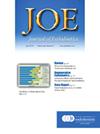新型多色热处理镍钛旋转系统的多方法分析:设计、冶金、机械性能和成型能力。
IF 3.6
2区 医学
Q1 DENTISTRY, ORAL SURGERY & MEDICINE
引用次数: 0
摘要
简介:本研究旨在采用多方法对新型多色旋转系统和四种热处理旋转仪器进行比较:本研究旨在采用多种方法对新型多色旋转系统和四种热处理旋转器械进行比较:对 RCS Rainbow、Rotate、RaCe EVO、OneCurve 和 ProTaper Ultimate 系统的三百台器械的设计(体视显微镜、扫描电子显微镜、三维表面扫描)、冶金和机械性能(循环疲劳、抗扭转性、抗弯曲和抗屈曲性、切割能力)进行了评估。使用显微 CT 评估了上颌磨牙牙道预备后的未预备表面。统计比较采用 Kruskal-Wallis 和单向方差分析后 Tukey 检验(α=5%):结果:仪器的主动叶片长度、螺旋数量和横截面设计均有变化。RCS Rainbow 显示了特定的相变温度、最高的抗弯(400.5gf)和抗折(286gf)值,以及最低的平均旋转角(529º)(P.05)。旋转仪器在机械测试中显示出中等数值。在未预备的牙道表面没有观察到差异(P>0.05):RCS Rainbow 在灵活性和其他机械性能之间进行了权衡。它的尺寸超过了其他器械,使其具有更高的抗扭矩能力,但同时也降低了其灵活性、旋转角度和切割能力。OneCurve 集几何设计和机械性能于一身,是一种非常均衡的选择。本文章由计算机程序翻译,如有差异,请以英文原文为准。
Multimethod Analysis of a Novel Multi-coloured Heat-treated Nickel-Titanium Rotary System: Design, Metallurgy, Mechanical Properties, and Shaping Ability
Introduction
This study aimed to compare a new multicolored rotary system with four heat-treated rotary instruments using the multimethod approach.
Methods
Three-hundred instruments of RCS Rainbow, Rotate, RaCe EVO, OneCurve, and ProTaper Ultimate systems were evaluated regarding their design (stereomicroscopy, scanning electron microscopy, and 3D surface scanning), metallurgy, and mechanical performance (cyclic fatigue, torsional resistance, bending and buckling resistance, and cutting ability). Unprepared surfaces after canal preparation of maxillary molars were evaluated using micro-computed tomography. Kruskal-Wallis and one-way analysis of variance post hoc Tukey tests were used for statistical comparisons (α = 5%).
Results
Instruments exhibited variations in active blade length, number of spirals, and cross-sectional designs. RCS Rainbow showed specific phase transformation temperatures, highest bending (400.5gf) and buckling (286gf) resistance values, and lowest mean angle of rotation (529°) (P < .05). OneCurve exhibited superior cutting ability (8.4 mm) and longer time to fracture (112s). RaCe EVO displayed the lowest time to fracture (51s), maximum torque (1.2 N.cm), buckling (174gf), and bending resistance (261gf) values (P < .05). ProTaper Ultimate showed the highest torque (1.6 N.cm) and angle of rotation (611°) (P < .05), while its bending load (262gf) was comparable to RaCe EVO (P > .05). Rotate instrument showed intermediate values in the mechanical tests. No difference was observed regarding the unprepared canal surfaces (P > .05)
Conclusions
RCS Rainbow demonstrates a trade-off between flexibility and other mechanical properties. Its dimensions exceeded those of other instruments, affording it higher torque resistance, yet concurrently reducing its flexibility, angle of rotation, and cutting ability. OneCurve stands out as a well-balanced choice by integrating geometric design and mechanical performance.
求助全文
通过发布文献求助,成功后即可免费获取论文全文。
去求助
来源期刊

Journal of endodontics
医学-牙科与口腔外科
CiteScore
8.80
自引率
9.50%
发文量
224
审稿时长
42 days
期刊介绍:
The Journal of Endodontics, the official journal of the American Association of Endodontists, publishes scientific articles, case reports and comparison studies evaluating materials and methods of pulp conservation and endodontic treatment. Endodontists and general dentists can learn about new concepts in root canal treatment and the latest advances in techniques and instrumentation in the one journal that helps them keep pace with rapid changes in this field.
 求助内容:
求助内容: 应助结果提醒方式:
应助结果提醒方式:


